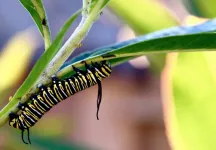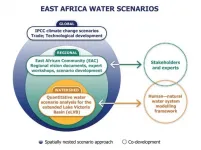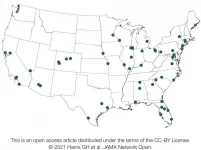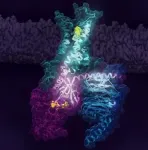Some of these species may be welcomed, such as sea turtles and the Florida manatee, which are expanding their ranges northward along the Atlantic Coast. Others, like the invasive Burmese python -- in the Florida Everglades, the largest measured 18 feet, end-to-end --maybe less so.
Equally unwelcome, and among the quickest to spread into warming areas, are the insects, including mosquitoes that carry diseases such as West Nile virus, Zika, dengue and yellow fever, and beetles that destroy native trees.
"Quite a few mosquito species are expanding northward, as well as a lot of forestry pests: bark beetles, the southern mountain pine beetle," said Caroline Williams, associate professor of integrative biology at the University of California, Berkeley, and a co-author of the paper. "In our study, we were really focusing on that boundary in the U.S. where we get that quick tropical-temperate transition. Changes in winter conditions are one of the major, if not the major, drivers of shifting distributions."
That transition zone, northward of which freezes occur every winter, has always been a barrier to species that evolved in more stable temperatures, said Williams, who specializes in insect metabolism -- in particular, how winter freezes and snow affect the survival of species.
"For the vast majority of organisms, if they freeze, they die," she said. "Cold snaps like the recent one in Texas might not happen for 30 or 50 or even 100 years, and then you see these widespread mortality events where tropical species that have been creeping northward are suddenly knocked back. But as the return times become longer and longer for these extreme cold events, it enables tropical species to get more and more of a foothold, and even maybe for populations to adapt in situ to allow them to tolerate more cold extremes in the future."
The study, conducted by a team of 16 scientists led by the U.S. Geological Survey (USGS), focused on the effects warming winters will have on the movement of a broad range of cold-sensitive tropical plants and animals into the Southern U.S., especially into the eight subtropical U.S. mainland states: Florida, Alabama, Mississippi, Louisiana, Texas, New Mexico, Arizona and California. Williams and Katie Marshall of the University of British Columbia in Vancouver co-wrote the section on insects for the study.
The team found that a number of tropical species, including insects, fish, reptiles, amphibians, mammals, grasses, shrubs and trees, are enlarging their ranges to the north. Among them are species native to the U.S., such as mangroves, which are tropical salt-tolerant trees; and snook, a warm water coastal sport fish; and invasive species such as Burmese pythons, Cuban tree frogs, Brazilian pepper trees and buffelgrass.
"We don't expect it to be a continuous process," said USGS research ecologist Michael Osland, the study's lead author. "There's going to be northward expansion, then contraction with extreme cold events, like the one that just occurred in Texas, and then movement again. But by the end of this century, we are expecting tropicalization to occur."
The authors document several decades' worth of changes in the frequency and intensity of extreme cold snaps in San Francisco, Tucson, New Orleans and Tampa - all cities with temperature records stretching back to at least 1948. In each city, they found, mean winter temperatures have risen over time, winter's coldest temperatures have gotten warmer, and there are fewer days each winter when the mercury falls below freezing.
Temperature records from San Francisco International Airport, for example, show that before 1980, each winter would typically see several sub-freezing days. For the past 20 years, there has been only one day with sub-freezing temperatures.
Changes already underway or anticipated in the home ranges of 22 plant and animal species from California to Florida include: Continuing displacement of temperate salt marsh plants by cold-sensitive mangrove forests along the Gulf and southern Atlantic coasts. While this encroachment has been happening over the last 30 years, with sea-level rise, mangroves may also move inland, displacing temperate and freshwater forests. Buffelgrass and other annual grasses moving into Southwestern deserts, fueling wildfire in native plant communities that have not evolved in conjunction with frequent fire. The likelihood that tropical mosquitos that can transmit encephalitis, West Nile virus and other diseases will further expand their ranges, putting millions of people and wildlife species at risk of these diseases. Probable northward movement, with warming winters, of the southern pine beetle, a pest that can damage commercially valuable pine forests in the Southeast. Recreational and commercial fisheries' disruption by changing migration patterns and the northward movement of coastal fishes. The changes are expected to result in some temperate zone plant and animal communities found today across the southern U.S. being replaced by tropical communities.
"Unfortunately, the general story is that the species that are going to do really well are the more generalist species -- their host plants or food sources are quite varied or widely distributed, and they have relatively wide thermal tolerance, so they can tolerate a wide range of conditions," Williams said. "And, by definition, these tend to be the pest species -- that is why they are pests: They are adaptable, widespread and relatively unbothered by changes in conditions, whereas, the more specialized or boutique species are tending to decline as they get displaced from their relatively narrow niche."
She cautioned that insect populations overall are falling worldwide.
"We are seeing an alarming decrease in total numbers in natural areas, managed areas, national parks, tropical rain forests -- globally," she said. " So, although we are seeing some widespread pest species increasing, the overall pattern is that insects are declining extremely rapidly."
The authors suggest in-depth laboratory studies to learn how tropical species can adapt to extreme conditions and modeling to show how lengthening intervals between cold snaps will affect plant and animal communities.
"On a hopeful note, it is not that we are heading for extinction of absolutely everything, but we need to prepare for widespread shifts in the distribution of biodiversity as climate, including winter climate, changes," Williams said. "The actions that we take over the next 20 years are going to be critical in determining our trajectory. In addition to obvious shifts, like reducing our carbon footprint, we need to protect and restore habitat for insects. Individuals can create habitat in their own backyards for insects by cultivating native plants that support pollinators and other native insects. Those are little things that people can do and that can be important in providing corridors for species to move through our very fragmented habitats."
INFORMATION:



